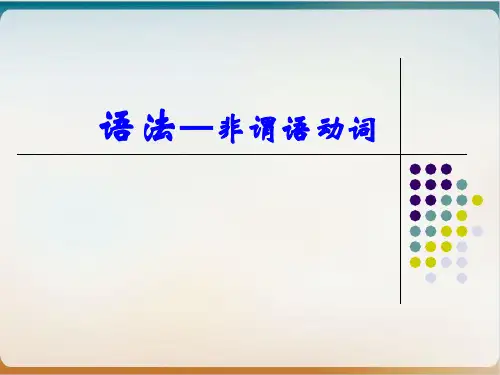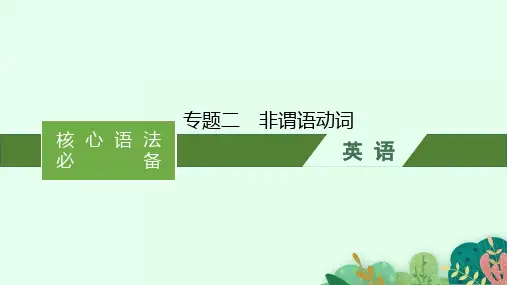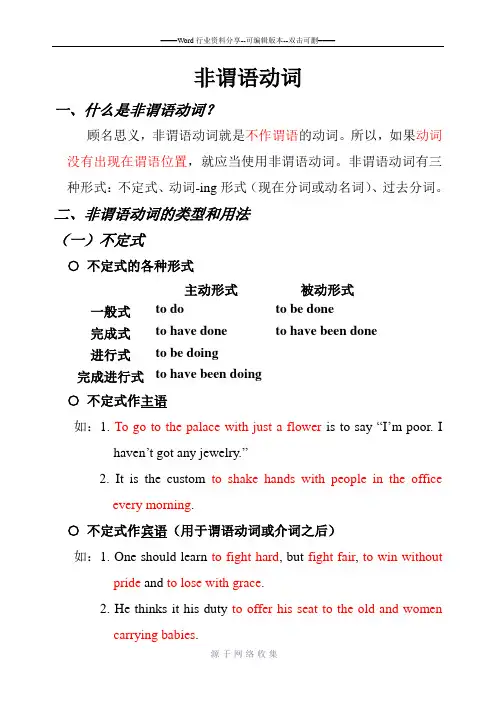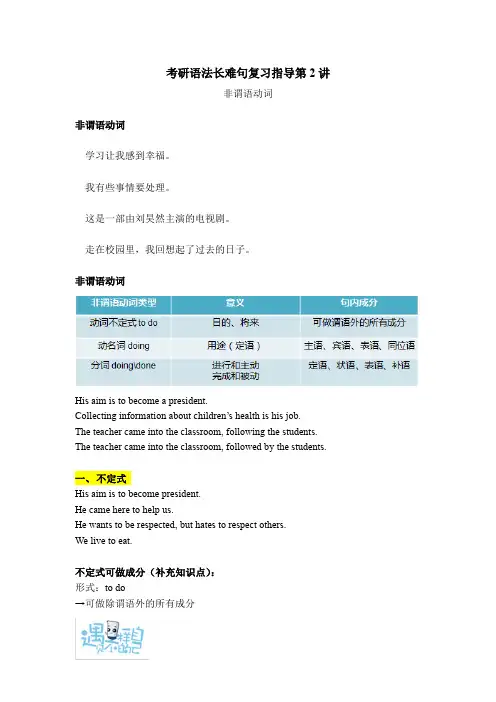英语语法系列讲座之二——非谓语动词
- 格式:doc
- 大小:52.00 KB
- 文档页数:5







非谓语动词一、什么是非谓语动词?顾名思义,非谓语动词就是不作谓语的动词。
所以,如果动词没有出现在谓语位置,就应当使用非谓语动词。
非谓语动词有三种形式:不定式、动词-ing形式(现在分词或动名词)、过去分词。
二、非谓语动词的类型和用法(一)不定式○不定式的各种形式主动形式被动形式一般式to do to be done完成式to have done to have been done进行式to be doing完成进行式to have been doing○不定式作主语如:1. To go to the palace with just a flower is to say “I’m poor. I haven’t got any jewelry.”2. It is the custom to shake hands with people in the officeevery morning.○不定式作宾语(用于谓语动词或介词之后)如:1. One should learn to fight hard, but fight fair, to win without pride and to lose with grace.2. He thinks it his duty to offer his seat to the old and womencarrying babies.○不定式作宾语补足语如:They don’t allow people to smoke.***请注意:不定式用于复合宾语中hard, difficult, easy等形容词之后构成宾语补足语时,使用一般式,表示被动意义。
如:I found this text very difficult to understand.○不定式作主语补足语如:1. He was asked to retell the story to the class.2. They were made to explain their late for class.○不定式作表语如:His job today is to be a guide for those foreign tourists.***请注意:不定式作表语,有时表示预先安排好的计划或约定要做的事或某事不可避免地将要发生。




1 语法系列讲座之二 非谓语动词 非谓语动词分为三类:不定式,动词-ing形式和过去分词 I 不定式 1.不带to的不定式 不定式通常由不定式符号to+动词原形构成。因此,不带to的不定式便与动词原形相同。不带to的不定式使用场合如下: (1)情态动词后:如: We needn’t stay long. You must do that. (2)短语情态动词:would rather, would sooner, would just as soon, may/might just as well, cannot but, cannot help but 后。如: You cannot help but respect him. (比较:You cannot help respecting him. 两句意思相同,但搭配不同。) (3)在“let, make, have等使役动词+宾语”后,在“see, hear, observe, notice, feel, watch等感觉动词+宾语”后。如: The teacher made his students do a lot of homework. I watched him eat his breakfast. (4)在“Why/Why not …”之后接不带to的不定式。 Why argue with him? Why not go there at once? 2.不定式符号to与介词to的辨别 我国学生在使用object to/ be used to这类结构时常会出错,以为这里的to是不定式符号,因而会说出I object to do it.(我反对做此事。)I’m used to do it.(我习惯做此事。)这样的病句来。殊不知,这里的to不是不定式符号,而是介词。既然是介词,其后就应该跟名词或代词;如果后接动词,动词应用-ing形式。 常见带介词to的短语有:admit to(承认),amount to (总计,等于),come to (到达,涉到),contribute to (有助于),object to (反对,不赞成),take to (从事,喜欢),be used to (习惯于),be devoted to (致力于),look forward to (盼望,期待),according to (根据,按照),owing to (因为,由于), in addition to (除……之外) He admitted to having taken the money. He is used to reading English without a dictionary. (比较:A dictionary can be used to help us read better. 字典可用来帮助我们更好地阅读。) In addition to singing an English song, she also danced at the party. 3.不定式的使用场合 (1)不定式与动词搭配 不定式结构能与某些动词搭配构成动宾关系,即不定式结构作动词宾语。这类搭配关系又可分为两种情况:动词+不定式;动词+宾语+不定式。 只能带不定式而不能带-ing形式作宾语的动词有:afford, agree, arrange, begin, care, choose, demand, expect, happen, hope, learn, love, manage, plan, want, wish 等。如: I don’t want to ask questions. 2
I managed to get a train ticket. 必须先带宾语然后再带不定式作宾补的动词有:see, hear, watch, feel等表感觉的动词;have, let, make, get等表“致使”的动词;arrange for, ask for, call on, depend on, long for等动词短语;consider, prove, think, believe, discover, imagine, judge, suppose, understand等表心理状态的动词;以及advise, allow, forbid, permit, require, urge等表“劝告”,“允许”,“禁止”等动词。如: Did you see him go out? Let us have a rest. I’ll arrange for you to come. I believe him to be honest. I advised him to study English. (2)名词+不定式 某些名词后要求接动词不定式, 构成名词+不定式的句型(不定式一般作名词的定语)。常用于这种结构中的名词有:ability, attempt, anything, chance, desire, decision, effort, failure, intention, opportunity, place, plan, reason, time, way, wish等,如: I have many reasons to fear her. They made an effort to finish the work in one day. 注意:不定式与其前的名词间一般有动宾关系,故不及物动词后须加适当的介词。 Here is a letter for you to type. The teacher told the students what kind of books to look for in the library. (3)形容词+不定式 不定式跟在某些形容词后,充当状语。常见的这类形容词有:able, afraid, angry, careful, careless, certain, difficult, eager, easy, happy, interesting, likely, ready, sure, unable, unwilling, wrong等。 如: Some of his ideas are difficult to understand. Are you ready to read the text? II 动词-ing形式 1.用动词-ing形式的场合 (1)常跟在某些动词或介词后作宾语。只能带-ing形式而不能带不定式作宾语的动词有:admit(接纳), appreciate(欣赏,感激), avoid(避免), cannot help(不禁), delay(延期), deny(否认), dislike(不喜欢), enjoy(享受,喜爱), finish(完成), give up(放弃), keep(保持), mind(介意), risk(冒……的危险), stop(停止), suggest(建议) 等。 如: Would you mind opening the door? I couldn’t help laughing when I heard him say that. (2)用于固定结构中:go+动词-ing, spend/waste (time, money)+动词-ing, be busy+动词-ing, be worth+动词-ing。如: I often go shopping (swimming, skating) on weekends. Don’t spend too much time watching TV. That man was busy writing a letter. Beijing is worth visiting. (3)在have difficulty (trouble, etc.) (in), have fun (in), It’s no good/no use/no point, 3
What’s the point/use of之后用动词-ing形式.如: It’s no use crying over spilt milk. What’s the point of leaving today’s work for tomorrow? I have difficulty (in) pronouncing this word. The child had great fun playing with his mother. 2.动词-ing形式和动词不定式 (1)在表“需要”意义的动词need, want, require, deserve等之后,用动词的-ing形式表被动,这相当于用动词不定式的被动语态。如: The desk needs repairing. (=The desk needs to be repaired.) This flower wants watering. (=The flower wants to be watered.) That boy deserves looking after. (=That boy deserves to be looked after.) (2)有些动词既可带动词不定式,也可带动词-ing形式,但所表达的意思不同。在forget, remember, regret等动词后,动词-ing形式表已经发生的动作,不定式表将要发生的动作。如: He has forgotten meeting him last year. (他忘了去年曾见过他。) He has forgotten to meet him. (他忘了要去见他。) 在go on, quit, stop, give up, leave off 等词后,动词-ing形式是宾语,不定式是目的状语。如: He stopped shouting because the teacher came in. (他停止大声喊叫,因为老师进来了。) He stopped to have a rest because he was very tired. (他停下来(手头边的事情)休息了一会,因为他非常疲惫。) III.动词-ing形式和过去分词 1.两种形式的区别 两种形式都具有形容词和副词作用,在句中可担当定、表、状、补语和独立主格结构。两者间的主要区别在于,动词-ing形式表示主动,正在进行等概念;过去分词表被动,动作完成等意思。如: a developed country (发达国家。完成“发展”) a developing country (发展中国家。表正在“发展”) The professor found some students writing letters in class. (主动) Have you read the poems written by Shakespeare? (被动) 2.使用两种动词形式需要注意以下几点: (1)动词-ing短语或过去分词作定语时,放在被修饰词的后面,功能相当于一个形容词从句。如: The boy playing there is my son. Tom ate the cake made by his mother. (2)有些动词,它们的-ing形式和过去分词形式都可以当形容词。两种形容词意义和用法不同,主要区别是:过去分词的形容词一般表“人感到(或对…)怎么样”,动词-ing形式则表“事物本身让人感到…怎么样”。如: I am interested in the story. (我对这部小说感兴趣。) I am reading an interesting story. (我在看一本有趣的故事书。) 试比较:disappointed, disappointing; excited, exciting; satisfied, satisfying; frightened, frightening; tired, tiring; amused, amusing (3)两种形式常用来作状语。动词-ing形式作状语时有主动的意思,过去分词